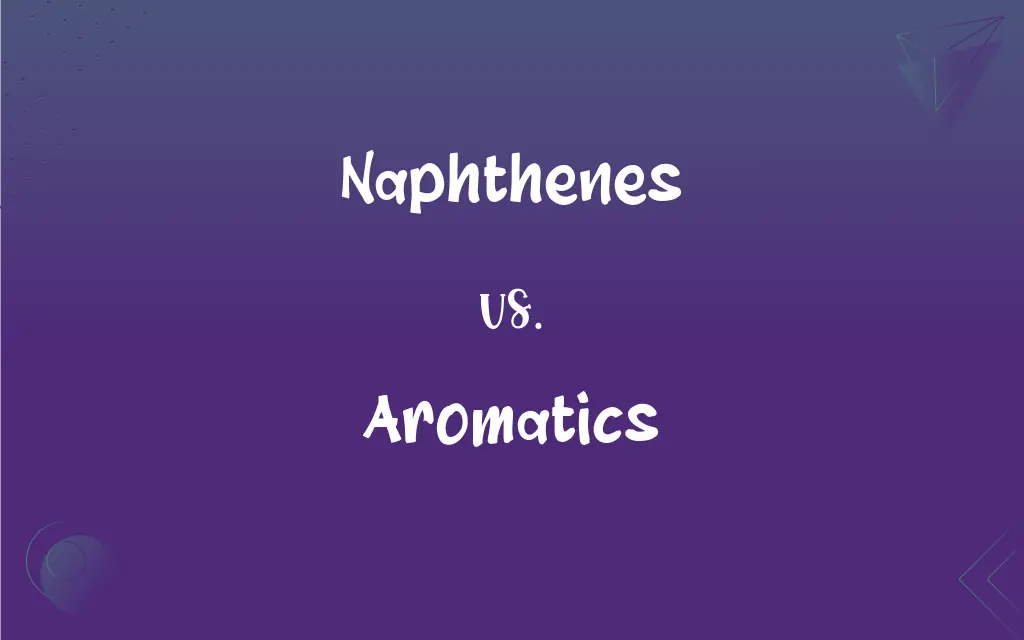Naphthenes vs. Aromatics: What's the Difference?
Edited by Aimie Carlson || By Janet White || Published on July 29, 2024
Naphthenes are saturated hydrocarbons with cycloalkane structures, offering stability and high energy content, whereas aromatics are unsaturated, containing at least one benzene ring, known for their distinct smells and chemical reactivity.

Key Differences
Naphthenes and aromatics are two classes of hydrocarbons distinct in their structure and properties. Naphthenes, also known as cycloalkanes, are characterized by their saturated carbon rings, making them stable and less reactive. Aromatics, on the other hand, contain one or more benzene rings, characterized by alternating double bonds, making them more reactive and often associated with distinct odors.
In terms of chemical structure, naphthenes are composed of carbon atoms joined in a ring, with single bonds, resulting in a saturated hydrocarbon. Aromatics, with their benzene rings, exhibit a planar, cyclic structure with delocalized π electrons across the ring, contributing to their chemical stability despite being unsaturated.
Naphthenes are found in significant quantities in crude oil and are important for producing high-energy fuels and lubricants due to their saturated nature and stability under various conditions. Aromatics, with their enhanced reactivity, are crucial in the chemical industry for manufacturing plastics, synthetic fibers, and dyes.
The environmental and health impacts of these compounds also differ. Naphthenes are relatively less toxic and less environmentally persistent compared to some aromatics, which can be hazardous and persistent in the environment, posing risks to human health and ecosystems.
From an industrial perspective, both naphthenes and aromatics are valuable; however, their applications differ due to their distinct chemical behaviors. Naphthenes are prized in fuel applications for their energy content, while aromatics are indispensable in the production of various chemicals and materials due to their unique reactive properties.
ADVERTISEMENT
Comparison Chart
Structure
Saturated hydrocarbons with cycloalkane rings.
Unsaturated hydrocarbons with one or more benzene rings.
Reactivity
Relatively stable and less reactive.
More reactive due to delocalized π electrons.
Sources
Abundant in crude oil.
Also found in crude oil but with distinct processing requirements.
Applications
Used in fuels and lubricants.
Crucial for producing plastics, synthetic fibers, and dyes.
Environmental Impact
Less toxic and environmentally persistent.
Some compounds can be hazardous and more persistent.
ADVERTISEMENT
Naphthenes and Aromatics Definitions
Naphthenes
Cycloalkanes with saturated carbon rings.
Cyclohexane, a naphthene, is utilized in the industrial production of nylon.
Aromatics
Contains at least one benzene ring.
Benzene, a common aromatic, is widely used in chemical synthesis.
Naphthenes
Less reactive, high energy content.
Due to their stability, naphthenes are preferred components in lubricants.
Aromatics
Known for distinct smells.
Many aromatics are key ingredients in perfumes due to their unique scents.
Naphthenes
Found in lubricating oils.
Naphthenic oils are known for their excellent cold-flow properties.
Aromatics
Environmentally persistent.
Some aromatic compounds, like polycyclic aromatic hydrocarbons, are concerning pollutants.
Naphthenes
Low toxicity compared to aromatics.
Naphthenes pose fewer environmental risks than many aromatic compounds.
Aromatics
Used in manufacturing plastics.
Toluene, an aromatic, is a precursor for making polyurethane foams.
Naphthenes
Stable hydrocarbons in crude oil.
Naphthenes are refined to produce high-quality jet fuels.
Aromatics
Characterized by delocalized π electrons.
The stability of aromatics is due to the electron delocalization in their rings.
Naphthenes
Any of several cycloalkane hydrocarbons having the general formula CnH2n and found in various petroleums.
Aromatics
Having an aroma; fragrant or sweet-smelling
Aromatic herbs.
Naphthenes
Plural of naphthene
Aromatics
(Chemistry) Of, relating to, or containing one or more molecular ring structures having properties of stability and reactivity characteristic of benzene.
Aromatics
An aromatic plant or substance, such as a medication.
Aromatics
(Chemistry) An aromatic organic compound.
Aromatics
Plural of aromatic
FAQs
What are naphthenes?
Naphthenes are a class of saturated hydrocarbons (cycloalkanes) with a general formula of CnH2n, where n is the number of carbon atoms. They are characterized by rings of carbon atoms.
Are naphthenes found in crude oil?
Yes, naphthenes are major components of many types of crude oil, contributing to its overall composition.
Do naphthenes have isomers?
Yes, naphthenes can have structural isomers due to variations in the arrangement of their carbon atoms.
What are the environmental impacts of naphthenes?
Some naphthenic acids, derived from naphthenes, can be toxic and persistent environmental pollutants, especially in waters near oil sands extraction sites.
Can naphthenes be converted to other hydrocarbons?
Yes, they can be converted to aromatic hydrocarbons through processes like catalytic reforming.
How do naphthenes differ from alkanes?
Unlike alkanes, which have a straight or branched chain structure, naphthenes have a cyclic structure.
Why are naphthenes important in the petroleum industry?
They are important because of their stability and are used in the production of high-quality lubricating oils and jet fuels.
Are all naphthenes cyclic?
Yes, by definition, naphthenes are cyclic hydrocarbons.
How do naphthenes react chemically?
They are relatively stable but can undergo reactions such as hydrogenation and cracking in industrial processes.
Why are they called 'aromatic'?
They were originally named for their distinct smells, as many early identified compounds had strong odors.
Are benzene and its derivatives the only aromatic compounds?
While benzene is the most well-known, there are many aromatic compounds, including naphthalene, toluene, and others with multiple rings or different substituents.
How are naphthenes separated from crude oil?
They are separated through fractional distillation and other refining processes that sort components based on boiling points and other properties.
Are aromatic compounds harmful?
Some aromatic compounds, especially polycyclic aromatic hydrocarbons (PAHs), are toxic and carcinogenic, posing environmental and health risks.
What makes aromatic compounds stable?
Their stability comes from the delocalized π electrons across the ring, which distribute energy evenly and resist addition reactions.
What role do aromatics play in the chemical industry?
Aromatics are key feedstocks for synthesizing plastics, synthetic fibers, dyes, detergents, and pharmaceuticals.
Can aromatics be found in nature?
Yes, aromatic compounds are found in natural products, including certain essential oils and biochemicals.
What are aromatics?
Aromatics are a class of hydrocarbons known for their stable ring structure, characterized by alternating single and double bonds, following Huckel's rule. The simplest aromatic hydrocarbon is benzene (C6H6).
How do aromatics differ from aliphatic hydrocarbons?
Aromatics have ring structures with delocalized π electrons, while aliphatic hydrocarbons can be either straight-chained, branched, or cyclic but lack the delocalized π electrons of aromatics.
How are aromatic compounds used in everyday products?
They are used in the manufacture of a wide range of products, including plastics, synthetic rubber, dyes, detergents, and medications.
How are aromatic compounds extracted from crude oil?
They are extracted using processes like catalytic reforming and extracted during the fractional distillation of petroleum.
About Author
Written by
Janet WhiteJanet White has been an esteemed writer and blogger for Difference Wiki. Holding a Master's degree in Science and Medical Journalism from the prestigious Boston University, she has consistently demonstrated her expertise and passion for her field. When she's not immersed in her work, Janet relishes her time exercising, delving into a good book, and cherishing moments with friends and family.
Edited by
Aimie CarlsonAimie Carlson, holding a master's degree in English literature, is a fervent English language enthusiast. She lends her writing talents to Difference Wiki, a prominent website that specializes in comparisons, offering readers insightful analyses that both captivate and inform.






































































